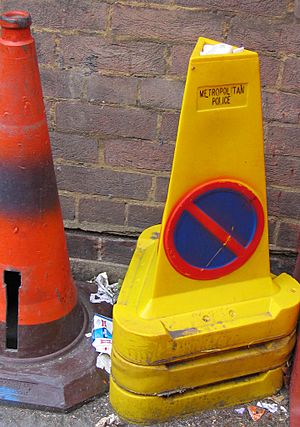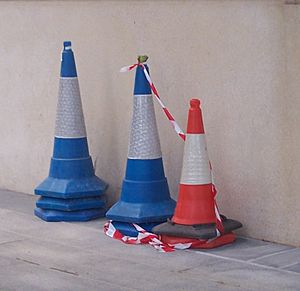Traffic cone facts for kids

Traffic cones (also called road cones, safety cones or pylons) are cone-shaped markers, usually made from plastic, that are put on roads to temporarily redirect automobile traffic in a safe manner.
Contents
Uses
Traffic cones are usually placed around construction sites or roadside accidents. As well, many utility companies such as telephone companies and electric companies place cones on the road when utility workers are working on or near the road. Cones are also used by driving schools to set up tests of turning and parking skills. They have many other uses including bike training, fun and for personal use like reserving parking spaces.
Features
Traffic cones are easily movable and about 60 cm (24 inches) tall. Traffic cones come in many different colors, with orange, yellow and red being the most common colors. Many types of traffic cones have reflective strips or stripes of reflective paint, so that the cones are easier to see at night.
History
Traffic cones were invented in 1914 by Charles P. Rudabaker. The first cones were made of concrete. In the 2000s, most cones are made of brightly-colored plastic.
Images for kids
-
Cones in use at the "Bridgegate" entrance to the George Washington Bridge in Fort Lee, New Jersey
-
Giant traffic cone in Seattle, Washington
-
Duke of Wellington statue, with cone (and reserve cones on standby)
-
Prank in Raglan, New Zealand
See also
 In Spanish: Cono de tráfico para niños
In Spanish: Cono de tráfico para niños






